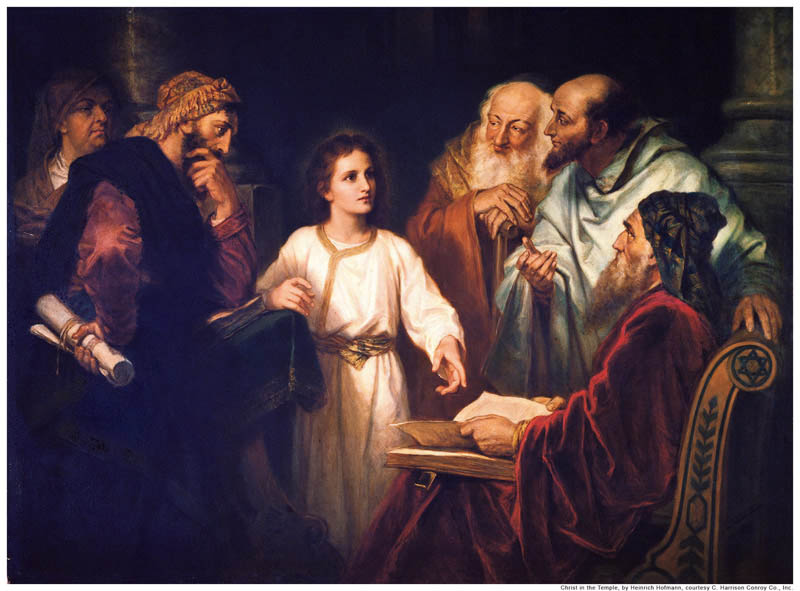Male Jewish babies are circumcised and give a name and a blessing at eight days of age. Luke 2:21 tells us that Mary and Joseph chose the name “Jesus,” which in Hebrew is Y’shua. Then, when Mary had finished her days of isolation according the Law of Moses (30 days), she and Joseph brought Jesus to the temple. Luke says that “they brought him to Jerusalem, to present him to the Lord” (v. 22). They brought two doves with them to sacrifice, which shows that they were poor. This presentation at the temple is interesting, because of the Jewish rite of Pidyon HaBen.
 In Luke 2:23 it says, “As it is written in the law of the Lord, Every male that openeth the womb shall be called holy to the Lord.” The firstborn son belonged to the temple and to the service of God. By making sacrifice and performing the pidyon haben, the firstborn son was relieved of this obligation. Thus, Christ, our Savior, the very God, did not serve in the temple. Instead, He became the great and last sacrifice on our behalf, and took upon Himself the sins of all mankind.
In Luke 2:23 it says, “As it is written in the law of the Lord, Every male that openeth the womb shall be called holy to the Lord.” The firstborn son belonged to the temple and to the service of God. By making sacrifice and performing the pidyon haben, the firstborn son was relieved of this obligation. Thus, Christ, our Savior, the very God, did not serve in the temple. Instead, He became the great and last sacrifice on our behalf, and took upon Himself the sins of all mankind.
At the temple, both Anna and Simeon recognized the child as the promised Messiah. While the priests and Levites unknowingly went through the motions of serving God in the temple, the Lord blessed these two with personal revelation, so that they knew the Messiah.
The visit of the Wise Men occurred after this, and it was their visit and inquiry made to Herod that aroused Herod’s jealousy. Joseph was warned in a dream to take the babe into Egypt to escape the wrath of Herod, who slaughtered the babies of Bethlehem in the hope of killing a future king. In Egypt the traditional location of Mary and Joseph’s sojourn in Egypt was Elephantine. Elephantine is an island in the Nile River in southern Egypt. A Jewish military group lived there from 650 B.C., and they obtained permission from Jerusalem to build a temple there. [1]
In Matthew 2 we learn that Joseph was again visited by an angel after Herod was dead, telling him it was safe to return to Israel, but hearing that Herod’s son ruled in Israel, Joseph led his little family back to Galilee.
The Bible is silent regarding most of Jesus’ childhood. Joseph was a carpenter in a small village, but the family were devoted, religious Jews. We do know that Jesus waxed strong and learned from grace to grace, line upon line. His calling gradually dawned on Him as He matured. He was so intelligent that He had no need to be taught.
Jews were required to make pilgrimage to the temple three times each year, for the spring festivals of Passover/Unleavened Bread/Bikkurim; the Feast of Weeks; and Feast of Trumpets/Day of Atonement/Feast of Tabernacles. Women, however, were not required to make these pilgrimages, because of their duties at home. It’s a demonstration of the family’s faithfulness that Mary accompanied Joseph at the time of Christ’s birth (at Passover) and at the time that they lost track of Jesus and found Him teaching in the temple. It appears that they were traveling in caravan with their extended family, so essentially, everyone went together (Luke 2:41-50).
The age of bar mitzvah is thirteen, and Jesus was just reaching this age when the family caravan went to Jerusalem for the Passover. This qualified Jesus to read from the scriptures and to expound on them. So we find Him “in the temple, sitting in the midst of the doctors, both hearing them, and asking them questions” (Luke 2:46). We can assume that they were amazed by His knowledge of the scriptures and His wisdom. Surely, He testified to them of the Messiah. “And Jesus increased in wisdom and stature, and in favour with God and man” (v. 52).
http://www.youtube.com/watch?v=sJuBUZTgjZc&feature=em-subs_digest
Jesus was perfectly obedient, and because he was, “he received all power, both in heaven and on earth.” ( Doctrine and C ovenants 93:17 . Emphasis added.) But Jesus did not receive this great power and glory all at once. He received it piecemeal, step by step, degree by degree, “line upon line, precept upon precept” ( D&C 128:21 ) until he received a fulness of the glory of the Father (see D&C 93:11–17 ).
